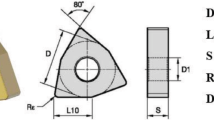Abstract
This paper presents an investigation on the cutting performance and wear behavior of single coated cermet and multilayer-coated carbide tools with distinct chip breaker geometries (MP and LP) when turning AISI 4340 steel (220 HV). Initially, the temperature of the chips was investigated under cutting speeds of 200, 250, and 300 m min−1, followed by the study of tool wear, wear mechanisms, and machined surface quality under cutting speed of 250 m min−1 using the MP chip breaker only. The results indicated that additionally to the increase in chip temperature with cutting speed, the cermet and the MP chip breaker were responsible for highest chip temperatures. With regard to tool wear, the coated cermet tool showed the largest values for maximum flank wear (VBBmax) up to a cutting length of approximately 7000 mm; however, at the end of the test, the cemented carbide presented larger flank and crater wear. Adhesive and abrasive wear mechanisms were observed, respectively, in the rake and flank faces of both tools. Moreover, notch wear and chipping were noticed on the coated carbide tool. Finally, the coated carbide tool provided superior machined surface quality, albeit roughness increased with cutting length for both tools.












Similar content being viewed by others
References
Ji W, Zou B, Zhang S, Xing H, Yun H, Wang Y (2018) Design and fabrication of gradient cermet composite cutting tool, and its cutting performance. J Alloys Compd 732(1):25–31. https://doi.org/10.1016/j.jallcom.2017.10.187
Peng Y, Miao H, Peng Z (2013) Development of TiCN-based cermets: mechanical properties and wear mechanism. Int J Refract Met Hard Mater 39(1):78–89. https://doi.org/10.1016/j.ijrmhm.2012.07.001
Klocke F (2011) Manufacturing processes 1: cutting. RWTH Ed. Springer, Germany
Ettmayer P, Kolaska H, Lengauer W, Dreyer K (1995) Ti (C, N) cermets—metallurgy and properties. Int J Refract Met Hard Mater 13(6):343–351. https://doi.org/10.1016/0263-4368(95)00027-G
Chen X, Xu J, Xiao Q (2015) Cutting performance and wear characteristics of Ti(C,N)-based cermet tool in machining hardened steel. Int J Refract Met Hard Mater 52(1):143–150. https://doi.org/10.1016/j.ijrmhm.2015.06.006
Klaasen H, Kübarsepp J, Roosaar T, Viljus M, Traksmaa R (2010) Adhesive wear performance of hardmetals and cermets. Wear 268(1):1122–1128. https://doi.org/10.1016/j.wear.2010.01.006
Canteli JA, Cantero JL, Marín NC, Gómez B, Gordo E, Miguélez MH (2010) Cutting performance of TiCN-HSS cermet in dry machining. J Mater Process Technol 210(1):122–128. https://doi.org/10.1016/j.jmatprotec.2009.08.003
Das A, Mukhopadhyay A, Patel SK, Biswal BB (2016) Comparative assessment on machinability aspects of AISI 4340 alloy steel using uncoated carbide and coated cermet inserts during hard turning. Arab J Sci Eng 41(11):4531–4552. https://doi.org/10.1007/s13369-016-2160-0
Bonifacio MER, Diniz AE (1994) Correlating tool wear, tool life, surface roughness and tool vibration in finish turning with coated carbide tools. Wear 173(1–2):137–144. https://doi.org/10.1016/0043-1648(94)90266-6
Hara H, Umemura T, Takesawa D (2016. (In Chinese)) Development of high toughness and high thermal conductivity cermet. 粉体および粉末冶金 63(10):900–904. https://doi.org/10.2497/jjspm.63.900
Zou B, Zhou H, Huang C, Xu K, Wang J (2015) Tool damage and machined-surface quality using hot-pressed sintering Ti(C7N3)/WC/TaC cermet cutting inserts for high-speed turning stainless steels. Int J Adv Manuf Technol 79(1–4):197–210. https://doi.org/10.1007/s00170-015-6823-x
Oh SW, Ahn SY, Oh KS, Lee H, Chung TJ (2015) Investigation into the microstructure and cutting performance of (Ti,Ta,W)(CN)-Co/Ni cermets. Int J Refract Met Hard Mater 53(1):36–40. https://doi.org/10.1016/j.ijrmhm.2015.04.017
MITSUBISHI. Mitsubishi materials: turning tools, rotating tools, tooling solutions, 2015
Yılmaz B, Karabulut Ş, Güllü A (2018) Performance analysis of new external chip breaker for efficient machining of Inconel 718 and optimization of the cutting parameters. J Manuf Process 32(1):553–563. https://doi.org/10.1016/j.jmapro.2018.03.025
Kalss W, Reiter A, Derflinger V, Gey C, Endrino JL, L J (2006) Modern coatings in high performance cutting applications. Int J Refract Met Hard Mater 24(5):399–404. https://doi.org/10.1016/j.ijrmhm.2005.11.005
G.Zheng, L.Li, Z.Li, J.Gao, J. and Z.Niu (2017) Wear mechanisms of coated tools in high-speed hard turning of high strength steel. Int J Adv Manuf Technol 94(9–12):4553–4563. https://doi.org/10.1007/s00170-017-1132-1
Liang X, Liu Z (2018) Tool wear behaviors and corresponding machined surface topography during high-speed machining of Ti-6Al-4V with fine grain tools. Tribol Int 121(1):321–332. https://doi.org/10.1016/j.triboint.2018.01.057
Hua J, Shivpuri R (2005) A cobalt diffusion based model for predicting crater Wear of carbide tools in machining titanium alloys. J Eng Mater Technol 127(1):136. https://doi.org/10.1115/1.1839192
Khrais SK, Lin YJ (2007) Wear mechanisms and tool performance of TiAlN PVD coated inserts during machining of AISI 4140 steel. Wear 262(1–2):64–69. https://doi.org/10.1016/j.wear.2006.03.052
Funding
This work was partly supported by the Coordenação de Aperfeiçoamento de Pessoal de Nível Superior—Brasil (CAPES)—Finance Code 001. The authors received financial support from the Fundação de Amparo à Pesquisa do Estado de Minas Gerais (FAPEMIG) and Conselho Nacional de Desenvolvimento Científico e Tecnológico(CNPq).
Author information
Authors and Affiliations
Corresponding author
Ethics declarations
Conflict of interest
The authors declare that they have no conflict of interest.
Additional information
Publisher’s note
Springer Nature remains neutral with regard to jurisdictional claims in published maps and institutional affiliations.
Rights and permissions
About this article
Cite this article
Reis, B.C.M., dos Santos, A.J., dos Santos, N.F.P. et al. Cutting performance and wear behavior of coated cermet and coated carbide tools when turning AISI 4340 steel. Int J Adv Manuf Technol 105, 1655–1663 (2019). https://doi.org/10.1007/s00170-019-04392-9
Received:
Accepted:
Published:
Issue Date:
DOI: https://doi.org/10.1007/s00170-019-04392-9




